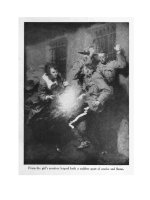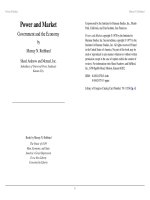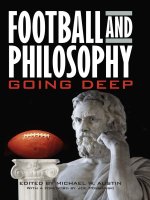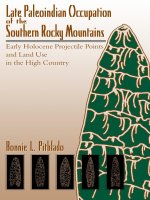university press of colorado hunter-gatherer archaeology of the colorado high country aug 2001
Bạn đang xem bản rút gọn của tài liệu. Xem và tải ngay bản đầy đủ của tài liệu tại đây (6.11 MB, 351 trang )
HUNTER-GATHERER ARCHAEOLOGY
OF THE
COLORADO HIGH COUNTRY
UNIVERSITY PRESS OF COLORADO
MARK STIGER
HUNTER-GATHERER
ARCHAEOLOGY
COLORADO HIGH COUNTRY
OF THE
Copyright © 2001 by the University Press of Colorado
International Standard Book Number 0-87081-612-8
Published by the University Press of Colorado
5589 Arapahoe Avenue, Suite 206C
Boulder, Colorado 80303
All rights reserved.
Printed in the United States of America.
The University Press of Colorado is a cooperative publishing enterprise supported, in part,
by Adams State College, Colorado State University, Fort Lewis College, Mesa State Col-
lege, Metropolitan State College of Denver, University of Colorado, University of North-
ern Colorado, University of Southern Colorado, and Western State College of Colorado.
The paper used in this publication meets the minimum requirements of the American
National Standard for Information Sciences—Permanence of Paper for Printed Library
Materials. ANSI Z39.48-1992
Library of Congress Cataloging-in-Publication Data
Stiger, Mark.
Hunter-gatherer archaeology of the Colorado high country / by Mark Stiger.
p. cm.
Includes bibliographical references and index.
ISBN 0-87081-612-8 (cloth : alk. paper)
1. Indians of North America—Colorado—Antiquities. 2. Indians of North America—
Colorado—Gunnison River Watershed—Antiquities. 3. Gunnison River Watershed (Colo.)—
Antiquities. 4. Colorado—Antiquities. I. Title.
E78.C6 S75 2001
978.8'17—dc21
2001000484
Designed and typeset by Daniel Pratt
10 09 08 07 06 05 04 03 02 01 10 9 8 7 6 5 4 3 2 1
To my colleagues in mountain archaeology
CONTENTS
List of Figures xiii
List of Tables xxi
Foreword xxiii
Preface xxv
Acknowledgments xxvii
Introduction xxix
1: THE ARCHAEOLOGY OF COLORADO’S HIGH COUNTRY 1
History of Research 1
Jennings’s 1968 Summary 1
Buckles’s Ute Prehistory Project on the Uncompahgre Plateau 3
Vail Pass Camp 4
Sisyphus Shelter 4
Harris Site 5
Sorrel Deer 5
Yarmony Pit House Site 5
Benedict’s Colorado Front Range Material 6
Mount Albion Complex (Benedict and Olson 1978) 6
Fourth of July Valley (Benedict 1981) 6
Arapaho Pass (Benedict 1985a) 7
Old Man Mountain (Benedict 1985b) 7
Coney Creek Valley (Benedict 1990) 7
Bode’s Draw (Benedict 1993) 7
Game Drives of Rocky Mountain National Park (Benedict 1996) 7
Other Research in the Upper Gunnison Basin 8
Curecanti National Recreation Area 8
Monarch Pass 9
viii
Cochetopa Dome 9
Lake Fork 9
Mount Emmons Project 10
Western Area Power Administration (WAPA) 10
Mill Creek Site Evaluation 10
Elk Creek Village 10
Uranium Mill Tailings Removal Act (UMTRA) Project 11
U.S. West Phone Line Project 11
Summary of Gunnison Basin Archaeological Research 11
2: CURRENT PERSPECTIVES IN COLORADO HIGH-COUNTRY ARCHAEOLOGY 13
Formation Processes 13
Guthrie’s Study Areas 16
Conventional Views of the Archaic 17
The Mountain Tradition as a Social Construct 18
The Concept of Social Relationships in Regional Archaeology 19
The Definition of Culture as a Mental Phenomenon 20
Social Processes as the Interchange of Ideas 20
Problems with Detecting Social Relationships 22
in the Archaeological Record
Theoretical Basis for Ethnic Explanations 23
Culture History of the Upper Gunnison Basin 26
Colorado Mountains Study Region Prehistory 26
(Guthrie et al. 1984)
The Oshara (Irwin-Williams 1973) 28
The Northern Colorado Plateau (Schroedl 1979) 29
The Western Archaic—General Statements 29
3: THE UPPER GUNNISON BASIN 33
Natural History of the Upper Gunnison Basin 33
Environmental Dynamics 34
Terminal Pleistocene 35
Post Pleistocene 36
Pollen 36
Macrofossils 36
Multiple Lines of Evidence in the San Juans 37
Summary of Natural History 38
The Tenderfoot Site 38
History of Investigations 40
Fieldwork 40
Excavations 41
Features 41
Lithic Artifact Analysis 43
Flotation Analysis 45
4: PREHISTORIC USE OF FAUNA IN THE UPPER GUNNISON BASIN 47
The Nature of Big Game Exploitation 49
as Evidenced by Pelvis and Scapula Elements
Contents
ix
Species Trends 50
Fauna at the Tenderfoot Site—A Spatial Analysis 51
Summary of Basin Faunal Exploitation 57
5: FLORAL EXPLOITATION IN THE UPPER GUNNISON BASIN 59
Temporal Patterns of Plant Use 59
Charcoal 59
Seeds 60
Summary 61
6: INTERPRETATION OF ARTIFACTS 63
Assemblage Structure—Theory and Definitions 63
Recognizing Assemblage Organization 64
Expectations for Assemblage Organization 66
Spatial Maintenance and Technological Organization 67
Assemblage Organization—Empirical Evidence 68
Summary of Burial Assemblages as Organizational Indicators 68
Summary of Hafted Tools 69
Archaeological Patterning of Bifaces at Tenderfoot 71
Lithic Technology in the Upper Gunnison Basin 75
Site Structure Analysis 79
Lithic Artifacts and Spatial Structure at Tenderfoot 80
All Artifacts 80
Artifact Size 81
Raw Materials 84
Technological Attributes 86
Tools 89
Bifaces 89
Projectile Points 92
Flake Tools 93
Unifaces 93
Hammerstones and Abraders 93
Ground Stone Tools 94
Cores 95
Summary of Tenderfoot Artifact Distributions 95
7: INTERPRETATION OF FEATURES 101
Firepits—Methods and Reasons 101
Summary of Ethnographic Fuel and Fire Use 101
Summary of Experimental Firepit Construction 102
Regional Patterning of Features 102
Classification of Features in the Upper Gunnison Basin 102
Feature Types 103
Fire-Cracked-Rock (FCR) Features 103
Big-Deep Fire-Cracked-Rock Features 103
Small-Shallow Fire-Cracked-Rock Features 109
FCR-Outside Features 110
Contents
x
Rock-Lined Firepits 110
Unlined Firepits 111
Boiling Pits 111
Structures 112
Amorphous Stains 112
Game Drives 113
Interpretation of Feature Variability 113
Numbers of Features Through Time 113
Sequence of Boiling Pits and Fire-Cracked-Rock Features 114
8: ABOUT SURFACE SITES 117
Surface Collections at the Tenderfoot Site 117
Comparison of Surface to Subsurface Materials 119
The Dynamic Nature of Surface Materials as 123
Shown by Repetitive Collections
Finer Spatial Scales of Analysis for the Surface Collection 125
The Research Value of Surface Sites 127
9: SITE COMPARISONS 129
Structures 130
Site 5GN205 130
Elk Creek Village 130
Checkers 131
Site 5GN247 131
VanTuyl Village 131
Zephyr Site 132
Tenderfoot Site 132
Abiquiu Reservoir, New Mexico 132
Site LA25358 132
Summary of Site LA25358 134
Site LA47940 134
Summary of Site LA47940 135
Site 5MT2731—Casa de Nada 135
Summary of Site 5MT2731 137
Kewclaw 137
Yarmony 137
Other Sites and Components 138
Site 5GN207 138
Mt. Bump Camp 138
Tenderfoot 139
Assemblage Interpretations 139
Site 5GN205 139
Tools 139
Elk Creek Village Block C 139
Abiquiu 139
Site LA25358, Area 1 140
Contents
xi
Site LA25358, Area 2 140
Site LA25358, Area 3 141
Site LA25358, Area 4 141
Site LA25358, Area 6 141
Tools—Site LA25358 143
Site LA47940 143
Tools 147
Casa de Nada 147
Tools 149
Kewclaw 149
Tools 151
Site 5GN207 151
Mt. Bump 152
VanTuyl Village 152
10: SUMMARY AND CONCLUSIONS 155
Who Were Those Guys? 155
The Nature of Surface Sites 156
and Their Value to Archaeological Research
Multiple Occupations 157
The Size of the Prehistoric System as Shown by Obsidian Distributions 157
Projectile-Point Styles 159
Stone Tools 161
Personal Gear 161
Site Furniture 162
Expedient Gear 162
Sequence of Technological Organization 162
Raw Material Use 162
Features 163
Game Drives in the High Country 163
Flora and Fauna 167
Explanation of the Cultural Sequence 168
The Early Paleoindian 169
The Late Paleoindian 169
The Archaic 170
Post-300 B.P. 171
Appendices
A: Tenderfoot Feature Descriptions by Erik Bjornstad 175
B: Lithic Sources in the Upper Gunnison Basin 215
C: Identified Sources of Archaeological Obsidian 223
Found in Colorado
D: Faunal Remains Found in the Upper Gunnison Basin 229
E: Floral Remains Found in the Upper Gunnison Basin 235
by Provenience
F: Burial Assemblages from Archaic and Basketmaker II Contexts 241
Contents
xii
G: Hafted Stone Tools in the Ethnographic 245
and Archaeological Records
H: Tenderfoot Tool Illustrations 251
I: Ethnographic Record of Fuel and Firepit Use 271
J: Experimental Firepit Construction 277
K: Descriptions of Features at Abiquiu and Casa de Nada 281
References Cited 289
Index 311
Contents
xiii
FIGURES
1.1. The locations of sites discussed. Sites are identified by num-
bers. (1) Dinosaur group; (2) Alva and Taylor Sites; (3)
Hurst’s sites; (4) Moore and Casebeir Sites; (5) Buckles’s
Uncompahgre sites; (6) Harris Site; (7) Sorrel Deer; (8)
Sisyphus Shelter; (9) Kewclaw; (10) Yarmony; (11) Vail Pass;
(12) Benedict’s Front Range sites; (13) Mt. Bump; (14) Casa
de Nada; (15) the Upper Gunnison Basin.
3.1. Map of the Upper Gunnison Basin.
3.2. Regional environmental change as shown by several lines of
evidence.
3.3. The large horizontal block excavation at Tenderfoot. Sage-
brush grows in the unexcavated areas of the site.
3.4. Map of features in block. Features are described and illus-
trated in Appendix A.
4.1. Map of highly fragmented bone at Tenderfoot. Contour
interval is 5 pieces.
4.2. Map of indeterminate-mammal bone at Tenderfoot. Con-
tour interval is 10 pieces.
4.3. Map of large-mammal bone, not including teeth or tooth
fragments, at Tenderfoot. Contour interval is 1 piece.
4.4. Map of large-mammal tooth fragments at Tenderfoot. Con-
tour interval is 10 pieces.
4.5. Map of medium-sized-mammal bone at Tenderfoot. Con-
tour interval is 1 piece.
4.6. Map of identifiable large-mammal bone at the Tenderfoot
Site. dsp = deer, sheep, and pronghorn-sized animal; ovis =
2
34
38
39
42
51
52
53
54
55
56
xiv
Ovis canadensis; odoc = Odocoileus hemionus. Numbers are
counts of large-mammal long-bone fragments.
4.7. Map of rabbit bone at the Tenderfoot Site. R = one rabbit
bone fragment, either jackrabbit or cottontail.
4.8. Map of rare species at the Tenderfoot Site.
6.1. Length versus width of Tenderfoot bifaces.
6.2. WOVERT and length of Tenderfoot bifaces.
6.3. Linear regression of biface base fragments, length versus
thickness.
6.4. Length versus thickness of Tenderfoot bifaces and preserved
wooden-handle notch depth.
6.5. Map of features and radiocarbon ages at the Tenderfoot
Site. All ages are B.P. based on a half-life of 5,570.
6.6. Distribution of all lithic debitage in the excavation block.
Contour interval is 25 pieces.
6.7. Distribution of tiny (< 0.05 g) artifacts. Contour interval is
10 pieces.
6.8. Distribution of artifacts weighing over 5 g. Contour inter-
val is 1 piece.
6.9. Distribution of quartzite artifacts. Contour interval is 50
pieces.
6.10. Distribution of silicified conglomerate. Contour interval is
10 pieces.
6.11. Distribution of chert artifacts. Contour interval is 5 pieces.
6.12. Distribution of obsidian artifacts. Contour interval is 1
piece.
6.13. Distribution of complete flakes. Contour interval is 10
pieces.
6.14. Distribution of flake fragments. Contour interval is 10
pieces.
6.15. Distribution of bifacial platforms. Contour interval is 5
pieces.
6.16. Distribution of normal platforms. Contour interval is 10
pieces.
6.17. Distribution of bifaces. Connecting lines indicate a refit
artifact.
6.18. Distribution of projectile points.
6.19. Distribution of flake tools.
6.20. Distribution of unifaces.
6.21. Distribution of hammerstones and abraders. Connecting
lines indicate a refit artifact.
6.22. Distribution of manos. Connecting lines indicate a refit
artifact.
6.23. Distribution of metates. Connecting lines indicate a refit
artifact.
Figures
57
58
72
73
74
75
80
81
82
83
84
85
86
87
88
89
90
91
92
93
94
95
96
97
98
xv
6.24. Distribution of cores.
7.1. Temporal distribution of feature types in the Upper
Gunnison Basin.
7.2. A big-deep fire-cracked-rock feature. All rocks but those on
the rim have been removed.
7.3. A small-shallow fire-cracked-rock feature. Note the Brunton
compass for scale.
7.4. A rock-lined firepit.
7.5. An unlined firepit.
7.6. A paired boiling pit.
7.7. A cribbed-log house during excavation. Rock slabs at cen-
ter of stain are the remains of the central firepit. Large daub
fragments with impressions were found around the perim-
eter of the structure.
7.8. Diameters of big-deep fire-cracked-rock features.
8.1. Surface collections at the Tenderfoot Site.
8.2. Artifacts recovered from the surface collections in the exca-
vation block. Left to right: Surface Collection 1, Surface
Collection 2, and Surface Collection 3.
8.3. Surface to subsurface artifact distribution comparisons in
the excavation block. Contour interval is 25 artifacts.
8.4. Isopleth map of surface collection counts per 10 meters
square.
9.1. Map of features at Site LA25358.
9.2. Map of analytical areas at Site LA25358.
9.3. Map of features at Site LA47940.
9.4. Map of features at Casa de Nada (Site 5MT2731).
9.5. Map of the stone tool distributions at Site 5GN205.
9.6. Map of the stone tool distributions at Elk Creek Village,
Block C.
9.7. Map of debitage regions at Site LA25358.
9.8. Map of cores at Site LA25358.
9.9. Map of unifaces at Site LA25358.
9.10. Map of bifaces at Site LA25358.
9.11. Map of tool fragments at Site LA25358.
9.12. Map of projectile points at Site LA25358.
9.13. Map of ground stone at Site LA25358.
9.14. Map of hammerstones/choppers at Site LA25358.
9.15. Map of debitage regions at Site LA47940.
9.16. Map of debitage regions at Casa de Nada (Site 5MT2731).
9.17. Map of projectile points at Casa de Nada (Site 5MT2731).
9.18. Map of cores and hammerstones at Casa de Nada (Site
5MT2731).
9.19. Map of bifaces at Casa de Nada (Site 5MT2731).
9.20. Map of tool fragments at Casa de Nada (Site 5MT2731).
Figures
99
108
108
109
110
111
112
113
115
118
121
122
124
133
134
135
136
138
139
142
142
143
144
144
145
145
146
147
148
148
149
150
150
xvi
9.21. Map of unifaces at Casa de Nada (Site 5MT2731).
9.22. Map of the stone tool distributions at Site 5GN207.
9.23. Map of the stone tool distributions at Mt. Bump Camp
(Site 5LK232).
10.1. Numbers of obsidian pieces found in Colorado for which
source analysis has been run.
10.2. Numbers of obsidian pieces found in Colorado that do
not come from New Mexico.
10.3. Temporal distribution of prehistoric houses in southern
Wyoming, Colorado, and northern New Mexico. Data
from Larson (1998) and Stiger (1986).
A.1. Feature 1.
A.2. Feature 2.
A.3. Feature 3.
A.4. Feature 4.
A.5. Feature 5.
A.6. Feature 6.
A.7. Feature 7.
A.8. Feature 8. Photo board is incomplete.
A.9. Feature 10.
A.10. Feature 11.
A.11. Feature 12. Half-excavated.
A.12. Feature 13. Photo board is incorrect.
A.13. Feature 14.
A.14. Feature 14. Floor feature in south end of structure.
A.15. Feature 17.
A.16. Feature 20.
A.17. Feature 21.
A.18. Feature 23.
A.19. Feature 24.
A.20. Feature 26.
A.21. Feature 28.
A.22. Feature 29.
A.23. Feature 30.
A.24. Feature 32.
A.25. Feature 39.
A.26. Feature 40.
A.27. Feature 41.
A.28. Feature 42.
A.29. Feature 43.
A.30. Feature 44.
A.31. Feature 45.
A.32. Feature 47.
A.33. Feature 48.
A.34. Feature 49.
Figures
151
152
153
158
159
174
189
189
190
190
191
191
192
192
193
193
194
194
195
195
196
196
197
197
198
198
199
199
200
200
201
201
202
202
203
203
204
204
205
205
xvii
A.35. Feature 50.
A.36. Feature 51.
A.37. Feature 53. Photo board is incorrect.
A.38. Features 53 and 55.
A.39. Feature 54.
A.40. Feature 55.
A.41. Feature 56.
A.42. Feature 57.
A.43. Feature 58.
A.44. Feature 60.
A.45. Feature 62.
A.46. Feature 63.
A.47. Feature 65.
A.48. Feature 66.
A.49. Feature 67.
B.1. Distribution of nonquartzite lithic raw material in the
Upper Gunnison Basin.
H.1. Complete, worn bifaces. Left to right: 1003N/1013E,
1003N/1004E, 996N/1012E, 1006N/1000E.
H.2. Complete bifaces. Left to right: 1006N/1007E, 1004N/
1009E, 997N/1013E, 995N/1000E.
H.3. Biface tips. Clockwise from upper left: 992N/1005E, 999N/
1000E, 1000N/1004, 1005N/1000E, 1007N/1008E,
1006N/1000E, 1004N/1001E.
H.4. Biface tips. Clockwise from upper left: 1000N/1006E,
1002N/1012E, 1007N/1005E, 1008N/1008E, 1002N/
1012E, 1000N/1007E, 1001N/1004E.
H.5. Biface tips. Left to right: 1000N/1002E, 1006N/1006E.
H.6. Biface fragments. Clockwise from upper left: 995N/999E,
1006N/1000E, 1001N/1000E, 993N/1003E, 999N/
1010E, 994N/999E, 995N/999E, 1007N/1000E.
H.7. Biface fragments Clockwise from upper left: 994N/1006E,
994N/1005E, 998N/1007E, 1009N/1013E, 1003N/
1006E.
H.8. Biface fragments. Clockwise from upper left: 994N/1007E,
1001N/1002E, 1004N/1011E, 1004N/1004E, 865N/
1064E, 1008N/1010E, 1001N/1004E.
H.9. Biface fragments. Clockwise from upper left: 1005N/1011E,
992N/1000E, 1000N/1014E, 992N/1000E, 997N/
1003E, 1003N/1010E.
H.10. Biface fragments. Clockwise from upper left: 1009N/999E,
1010N/1006E, 1005N/1009E, 1004N/1006E, 1003N/
1011E, 994N/1008E, 1006N/1008E.
H.11. Biface fragments. Clockwise from upper left: 1005N/1003E
(refits to artifact from 1002N/1006E), 995N/1014E,
Figures
206
206
207
207
208
208
209
209
210
210
211
211
212
213
213
217
251
252
252
253
253
254
254
255
255
256
256
xviii
994N/1002E, 1008N/1001E, 1007N/1004E, 1002N/
1006E (refits to artifact from 1005N/1003E).
H.12. Refit biface. Clockwise from upper left: 1000N/1012E,
1004N/1001E, 1044N/1014E.
H.13. Refit bifaces. Clockwise from upper left: 1001N/1004E,
993N/1004E, 995N/1004E, 1002N/1006E.
H.14. Refit bifaces. Left to right: 1000N/1004E, 1007N/1005E,
1004N/1000E, 999N/1007E, 1002N/1006E.
H.15. Refit bifaces. Middle artifact base was stolen from labora-
tory after analysis. Clockwise from upper left: 1003N/1000E,
1001N/1003E, 1001N/1005E, 1002N/1002E, 1004N/
1000E (missing), 1004N/1002E.
H.16. Projectile-point fragment. 1009N/1008E.
H.17. Projectile points. Top left to right: 1002N/1007E, 1004N/
1000E. Middle left to right: 1002N/1007E, 991N/1007E,
997N/1001E, 997N/1010E, 998N/1011E, 995N/1010E,
991N/1002E. Bottom left to right: 1006N/1000E, 1005N/
1005E, 998N/1009E, 993N/1010E, 992N/1007E,
1009N/1008E.
H.18. Projectile-point fragments. Top left to right: 997N/1003E,
996N/999E. Middle left to right: 1000N/1000E, 994N/
1002E, 998N/1001E, 1007N/1013E, 998N/1004E,
1000N/1001E, 1002N/1007E. Bottom left to right: 1002N/
1003E, 998N/1007E, 995N/1001E, 998N/1002E,
1001N/1007E, 1008N/1009E, 996N/1002E, 1005N/
1001E, 998N/1002E.
H.19. Flake tools. Clockwise from upper left: 1007N/1013E, 999N/
1006E, 1006N/999E, 999N/1010E, 1003N/1005E,
995N/1007E, 993N/1011E, 996N/1000E.
H.20. Unifacial tools. Clockwise from upper left: 1003N/1003E,
996N/1012E, 1008N/1008E, 1006N/1004E, 996N/
1003E, 999N/1007E, 1002N/1009E.
H.21. Large flake tools. Clockwise from upper left: 996N/1003E,
996N/1013E, 992N/1007E, 995N/1009E, 1003N/
1004E, 1003N/1002E, 1000N/1008E.
H.22. Flake tools. Clockwise from upper left: 1009N/1005E, 865N/
1064E, 997N/1006E, 1005N/1004E, 996N/1001E,
1004N/1013E, 998N/1004E, 999N/1006E, 1003N/
1008E, 1005N/1001E, 995N/1008E.
H.23. Unifacial tools. Left to right: 996N/1012E, 999N/1006E,
996N/1012E, 991N/1004E.
H.24. Small flake tools. Left to right: 1004N/1012E, 992N/
1000E.
H.25. Two bifaces and a uniface made from nonlocal material.
Left to right: 998N/1007E, 1004N/999E, 1000N/1013E.
Figures
257
257
258
258
259
259
260
260
261
261
262
262
263
263
xix
Figures
H.26. Roughly bifacial tools. Clockwise from upper left: 1000N/
1000E, 998N/1007E, 1007N/999E, 997N/1002E,
994N/1006E, 1002N/1013E, 992N/999E, 1009N/
999E, 997N/1004E, 994N/1000E, 1007N/1006E.
H.27. Flake tools. Left to right: 1000N/1012E, 994N/1005E,
1002N/1007E.
H.28. Bone awl or needle tip. 1002N/1003E.
H.29. Stemmed projectile points. Left to right: 991N/1002E,
992N/1007E, 993N/1010E.
H.30. Paleoindian points. Clockwise from top: 1006N/1012E,
986N/1013E, 985N/1015E, 998N/1009E.
H.31. Unifaces of nonlocal material. Clockwise from upper left:
1002N/1009E, 1008N/1008E, 997N/999E, 989N/
1010E, 1000N/1013E.
H.32. Manos. Top left: 1007N/1005E. Bottom left: 1003N/1002E.
Right: 1003N/1004E.
H.33. Corner-notched points. Clockwise from upper left: 1009N/
1008E, 1005N/1005E, 1006N/1000E, 1007N/1005E,
1010N/999E.
H.34. Choppers. Left to right: 869N/1052E, 1000N/1000E.
H.35. Refit bifaces of local silicified conglomerate. Top left to right
(tips): 1003N/1000E, 1001N/1005E, 989N/1001E,
1001N/1004E. Bottom left to right (bases): 1004N/1002E,
1002N/1002E, 986N/1003E, 1008N/1005E.
H.36. Abrader. 1001N/1004E.
J.1. Thermocouple measurements for firepit experiments.
264
264
265
265
266
267
267
268
268
269
269
278
TABLES
4.1. Animals identified in prehistoric archaeological deposits in
the Upper Gunnison Basin.
5.1. Plants identified in archaeological deposits in the Upper
Gunnison Basin. Charred material only.
6.1. Archaic and Anasazi assemblage differences.
7.1. Feature typology for the Upper Gunnison Basin.
7.2. Radiocarbon-dated features from the Upper Gunnison
Basin.
8.1. Comparison of mean values among surface collections across
the entire site.
8.2. Chi-square value of differences among collections across
the entire site.
8.3. Comparison of repeated surface collections across the entire
site. Tool-debitage ratios for high-frequency raw material.
8.4. Attributes relatively similar among surface collections within
individual clusters.
8.5. Comparison of tool-debitage ratio by repeated collection
within clusters.
8.6. Chi-square values of differences among repeated collections
within Clusters 1–4 by material type.
9.1. Radiocarbon dates from Sites LA25358, LA47490, and
5MT2731 (Casa de Nada). Data from Stiger (1986:268).
10.1. The Yarmony model of site types.
10.2. Radiocarbon dates on corn from Uncompahgre Plateau
sites—dates corrected for isotopic fractionation.
10.3. Dendrochronological dates from Tabeguache Cave. Dates
48
60
76
103
104–107
119
123
123
125
s
126
126
136
168
172
173
xxii
Tables
from unpublished research by John Gooding, notes on file
at the C. T. Hurst Museum.
C.1. Sources for obsidian artifacts in Colorado.
D.1. Faunal remains Found in the Upper Gunnison Basin.
E.1. Floral remains and proveniences identified from sites in the
Upper Gunnison Basin.
F.1. List of burial assemblages from Archaic and Basketmaker
II contexts.
J.1. Results of flotation separation of experimental firepit
contents.
223–227
230–233
235–239
241–244
279
xxiii
FOREWORD
As a long-time advocate of the abandonment of interpretative conventions in
favor of research and scholarship aimed at improving our inferential methods, I
am very pleased to have been asked to write the foreword for Mark Stiger’s
pioneering book. Mark has repeatedly suggested that the use of interpretative
conventions insures that learning ceases. The use of interpretative conventions or
models constructed for the data to interpret the past from archaeological re-
mains insures that what is already thought to be known is simply translated in a
new and previously unstudied area. Guided by this viewpoint, Mark has con-
ducted intensive field research in the region of the Upper Gunnison Basin. This
research, well described here, is related to the work of others from surrounding
areas as he begins to develop a descriptive synthesis of patterning demonstrable
within the regional archaeological record. He provocatively documents fascinat-
ing changes through time suggestive of major shifts in the ways the region was used
and in the organizational properties of the systems represented. The old view of a
static Desert culture, previously said to characterize the region, is not sustained.
Mark’s work goes far beyond the construction of temporal patterning for
the region; he addresses the limitations of interpretative conventions directly. For
instance, he argues that the use of projectile point styles as discrete temporal
indicators is unjustified since multiple forms occur together in burial as well as
cache contexts. The assumption of single-style time blocks seems empirically un-
justified. His strategy is to shift the scale of associational patterning from C-14
dates to features that have a high probability of representing specific events. He
uses this scale-shifting strategy to address the issue of high-altitude game drives,
traps, and other stone constructions. It is correctly pointed out that interpreta-
tion has traditionally proceeded by virtue of referral to vague analogies between
high-altitude features and ethnographic descriptions of Eskimo caribou drives
xxiv
and /or plains bison drives. More detailed examination of the latter case descrip-
tions reveals many features that are not likely to be analogous, much less homolo-
gous, with the high-altitude features described from the region. He suggests alter-
native ways of looking at the periodicity in the construction of such features: as
clues to the state of the systems and the peoples investing in such constructions.
I should mention that while Mark’s work is not specifically presented as a
treatment of analytical approaches, he nevertheless demonstrates the value of
seeking patterning at very different scales and of using very different frames of
reference against which to array his data.
He has primarily used geographic, environmental, temporal, and contextual
frames of reference, with a clear understanding that what might be conditioning
changes in the internal organization of residential structures could be very differ-
ent from what might be conditioning temporal periodicities in the construction
of game drives.
I must commend Mark for organizing his data and presenting it in ways
faithful to the observational provenance and, at the same time, in sufficient detail
to make it possible for future researchers to use his observations in comparative
pattern recognition studies. Of course such studies could be conducted at scales
only made possible by the accumulation of observations from many different
field researchers. Unlike many contemporary archaeologists, Mark is well aware
of his role as a contributor to the long-term accumulation of data and observa-
tions in our field. Regrettably, many current archaeologists see the archaeological
record as a source of materials to be organized in support of their “trendy”
interpretations; therefore the issue of subsequent use in analysis by future genera-
tions of researchers is always appreciated. Mark is clearly a responsible, forward-
thinking archaeologist
Throughout the book, Mark is continuously aware of the possible articula-
tions between features and tasks, and, in turn, tasks and tactics. If one is to study
the archaeological record for purposes of understanding the past that was, in-
depth linkages must be forged among observations, implications to action, and
the issue of what conditions such actions; these linkages must be continuously
advanced and modified in the difficult task of theory building. It is growth in the
latter activity and the integration of theory building into the normal activities of
archaeologists that will advance the field of archaeology and gradually transform
our humanistic discipline, which demands interpretation in human terms, into a
science, which seeks explanations for patterning demonstrable in our data as
generated from the archaeological record.
—LEWIS R. BINFORD
DALLAS, TEXAS
Foreword









